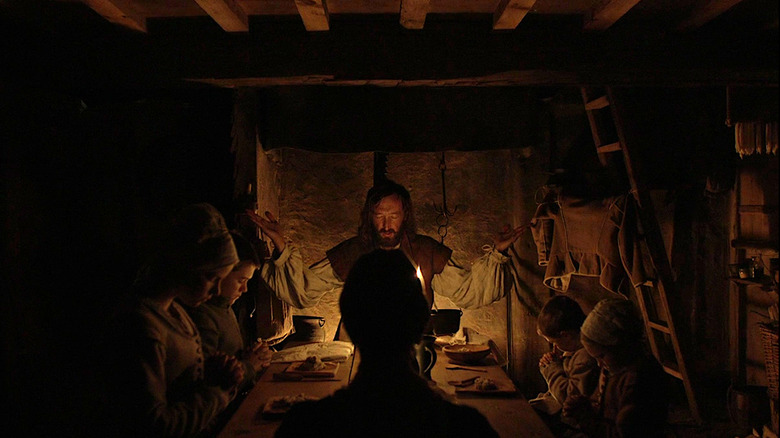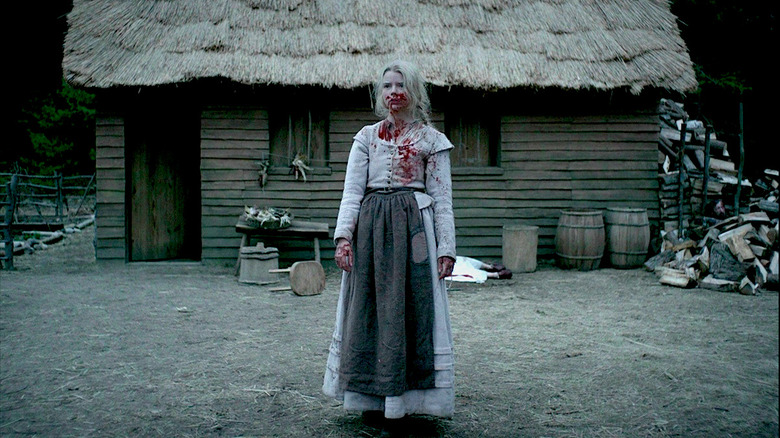Robert Eggers Was Concerned The Witch Could Traumatize Its Cast
In 2015, Robert Eggers blew us all away with his directorial debut, "The Witch" (or "The VVitch," if you're fancy). Set in a puritanical New England village, a family is banished from their colony and forced to start a new life for themselves alone in the wilderness. It is the 1600s and everyone is suspicious of anyone who goes against dominant beliefs. Witches are real, and they have the ability to ruin lives for their own twisted gains. William and his wife Katherine know this, so when strange things begin to happen on their own farm — like, say, the abrupt disappearance (and I mean abrupt) of their youngest son — they suspect a witch has come to curse them.
So much of "The Witch" is about atmosphere. The film is filled with tense scenes that are meant to set our nerves on edge without ever actually revealing something particularly terrifying. It is the perfect breeding ground for paranoia, and the movie sometimes feels like walking through a long, pitch-black tunnel. You know there is a light at the end, a resolution to the fear, but you lack the ability to clearly see your immediate surroundings, so every one of your senses is on high alert. Maybe you won't make it out of the tunnel. Maybe there are unseen things hiding in the dark, waiting for you instead.
"The Witch" is ultimately a story about family and family betrayal, and in order to create a film in which the family unit falls to pieces, Eggers wanted to make sure his cast felt comfortable with each other from the beginning. The movie deals with some pretty dark stuff, and Eggers was worried he would be traumatizing his actors too much with some of the material he was asking them to reenact. To prevent this, he made sure to do everything he could to keep the potential for trauma to a minimum.
The difference between trauma and suffering
If you've done your research on the Puritans, you know they were a paranoid bunch. Someone else was always at fault for your misfortune, which is exactly what Eggers is trying to convey in "The Witch." "I want you to feel like a Puritan dreading everything, all the time," he says in an article for Backstage. But too much suspicion and dread, especially in the actual lives of the actors portraying the family in his film, is not what Eggers was going for. However, it was not always possible to shield his cast from some of the film's more disturbing moments.
Backstage goes into detail about how some of the cast members were visibly distraught over the things going on in the film. Kate Dickie, who plays Katherine, and Anya Taylor-Joy, who plays her daughter Thomasin, even had visceral emotional reactions to particularly difficult scenes, which Backstage notes they often talked about during press interviews for the film. Still, Eggers tried to minimize the amount of trauma his actors went through by spending a week before filming just running basic rehearsals which gave the cast a chance to get to know each other and create their own bond. "It was all about having enough rehearsal and feeling safe and trusting each other," says Eggers.
Eggers' approach to directing difficult material seems to start with creating a strong foundation amongst his cast. However, he didn't always feel this way. He tells Backstage that when he was younger, he "thought terrorizing actors emotionally was a really good idea," but as he's aged, he's realized that "getting there through love and support is the best way to do it. Otherwise, you're just going to damage each other."
Therefore, his approach to tackling "The Witch" was first and foremost about the trust between cast members. Eggers draws a distinct line between suffering and trauma, as well, seeing his actors as openly allowing themselves to suffer for the sake of the art. He says, "If you're suffering and it's self-imposed to better the work, that's privilege. Sometimes it's not about it being comfortable, but it needs to be the actor's choice." And, perhaps, therein lies the secret to living deliciously. Wouldst thou like to give it a try?

